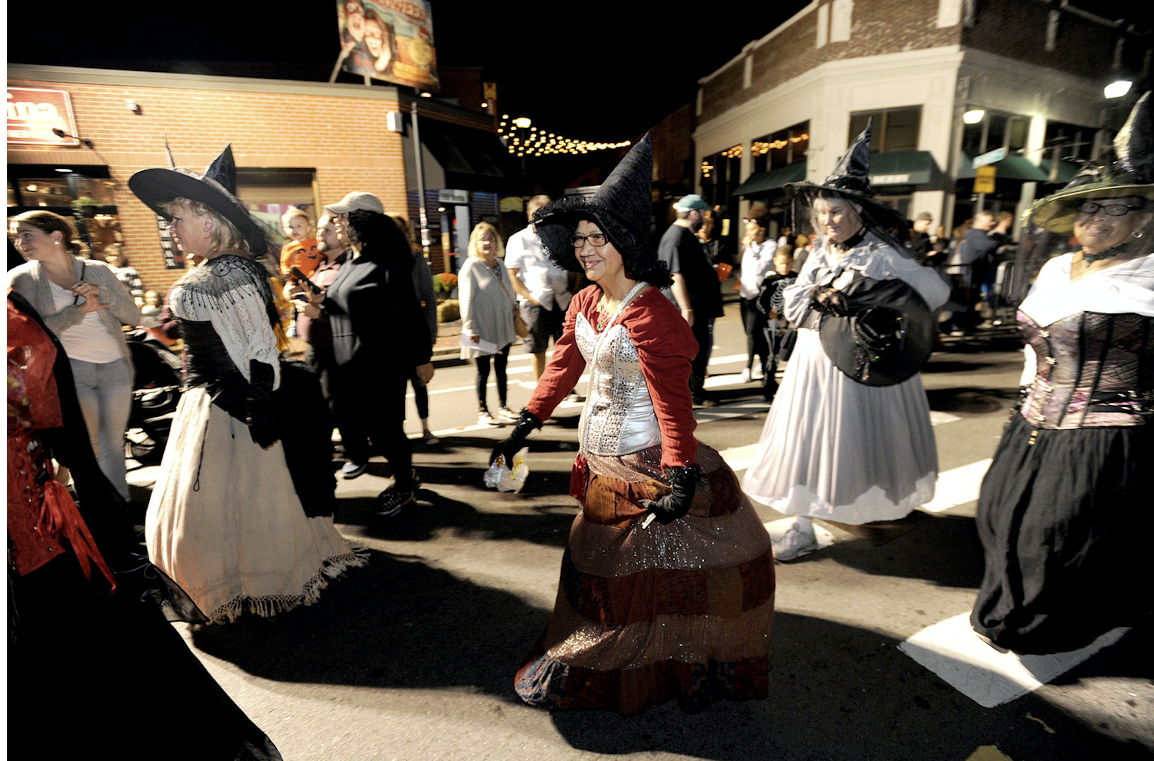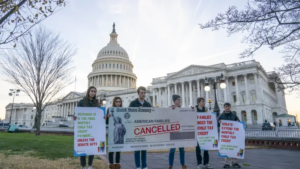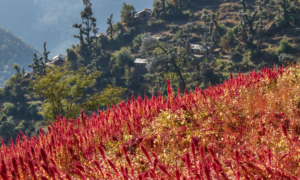Salem, Massachusetts, balances profit and tribute. How can other popular witch history sites do the same?
Centuries after a witch panic swept through Europe and parts of America, witches still cast a mighty spell. They’re ascribed astonishing powers, romanticized, and reincarnated as Halloween decorations. They star in film, on stage, and on TV, often depicted as “wicked,” but sometimes as “good,” and even lovable.
In reality, witches and those accused of using magic are real people. Their stories—appropriated and not always accurately told—bring revenue to places associated with the occult, places such as Salem, Massachusetts, and Zugarramurdi, the “Salem of Spain.”
But with increasing awareness of present-day persecution of people—mostly women—for witchcraft around the world, there’s a growing unease about how we remember the men, women, and children lost to witch hunts in tourist towns. The question is: How do we balance commemoration with commodification? The answer isn’t easy.
WITCH KITSCH
Every Halloween, images of the hooked-nosed woman wearing a pointy hat crop up across the United States, perhaps nowhere more so than in Salem.
In pre-pandemic years, nearly a million tourists generate $140 million in the city now synonymous with the witch trials of 1692, in which 19 people were executed for witchcraft. The month-long Halloween celebration is the biggest draw, accounting for more than 30 percent of the city’s annual visitors, who arrive in costume and snap photos of police wearing pointy-hatted patches and shop for witch-adorned shot glasses.
A similar scene occurs year-round in Zugarramurdi, in northern Spain, where 7,000 people were accused of witchcraft during the Basque witch trials of the early 1600s. Visitors tour a nearby cave, where conjurers were said to cavort with the devil (disguised as a goat); visit a museum devoted to the history; and shop for witch-themed tchotchkes.
But while witch tourism may be fun, some scholars worry that these stereotypes do more harm than good. The selling of dolls in gift shops like those in Spain “perpetuates the idea that the so-called witches … were not victims of a terrible persecution, but were fictional figures,” says Silvia Federici, author of Caliban and the Witch. “I do not think the tourists who buy these dolls realize that these were women who were charged with fictional crimes, and then horribly tortured and most often burned alive.”
HISTORY REPEATING
From the late 16th to mid-17th centuries, fear of witchcraft spread across early modern-era Europe. At that time, land disputes, unexplained illnesses, and suspicion of transgressive or powerful women were among the sources of accusations of witchcraft. In the process, tens of thousands of innocent people were killed in witchcraft trials.
(Related: A royal obsession with black magic led to Europe’s most brutal witch hunts.)
Witchcraft is difficult to describe. Britannica categorizes it as a religious belief and defines it as “the exercise or invocation of alleged supernatural powers to control people or events, practices typically involving sorcery or magic.” But witchcraft encompasses a wide range of cultural and regional beliefs, from shamanism to metaphysical ideas to pre-Christian folkloric traditions that historically have been viewed negatively.
Hundreds of years later, misperception around witchcraft still circulates. As a result, witch hunts are very much a 21st-century practice in many parts of the world, particularly in sub-Saharan Africa, India, and Papua New Guinea.
While authorities in most countries simply turn a blind eye, some legal systems sanction the persecution. In addition to having laws against sorcery (a crime that carries a death sentence), Saudi Arabia established an anti-witchcraft unit in 2009 within the country’s religious police department.
Why witch hunts have escalated in some parts of the world is a difficult question to answer. Besides the same conflicts prevalent in early modern Europe, witchcraft can be a convenient cloak for the increasing problem of gender-based violence. “Violence against women has greatly intensified in recent years,” says Federici, “for reasons, I believe, that have some relation to the violence inflicted on women through the witch hunts of the past.”
The failure to recognize the history of the witch hunts may be a factor, too. “No ‘day of memory’ has been introduced in any European calendar,” writes Federici in the introduction to her 2018 collection of essays Witches, Witch-Hunting, and Women. The victims’ history can’t “be buried in silence unless we want their destiny to be repeated, as is already happening in many parts of the world.”
A MORE FITTING COMMEMORATION
Around the world, there are efforts to go beyond the broomstick-riding cliché and realistically recognize this dark history. Salem, Massachusetts’ “Proctor’s Ledge” is an understated landscaped area, where the accused were hung in 1692. In Essex, England, a small plaque lists the names of the 33 victims held at Castle Park.
In Scotland, a stone plaque in the Orkney Islands remembers the 80 people killed at Gallow Ha’. Along the Fife Coastal Path, three plaques note the 380 people accused of witchcraft. Also in Fife, government officials in 2019 proposed a 200-year-old lighthouse dedicated to the county’s most famous victim, Lilias Adie (who died in prison in 1704 while awaiting trial) and all victims of the country’s witch panic. Ultimately, however, that campaign was defeated.
But none match the scale and impact of Norway’s Steilneset Memorial. Erected in 2011, the structure describes the lives of the 77 women and 14 men executed in the 17th-century Finnmark witch trials. Visitors come upon it at the end of the Norwegian Scenic Route Varanger, at the edge of the Barents Sea, into which accused witches were thrown. If they floated, they were guilty.
Architect Peter Zumthor designed a long pavilion leading to a steel and smoked-glass box. Inside the box, artist Louise Bourgeois’ sculpture “The Damned, The Possessed and The Beloved” (2007–2010) highlights a burning steel chair encircled by mirrors.
Next to each of the pavilion’s 91 steel-frame windows (one for each victim), text printed on silk—written by historian Liv Helene Willumsen and based on court records—name the victims, the charges brought against them, and their sentence. Among the remembered: the Sámi woman Karen Edisdatter, who was the first of 13 women blamed for a shipwreck in 1617; and Marette, known only as “Torsten’s wife,” who was burned at the stake in 1645 and “left only a pair of blue pants and an old sweater.”
“I was very much aware of the danger of romanticizing the witchcraft trials,” says Willumsen. “I tried to treat the historical material in a respectful way, not to dramatize. I want to give the victims their dignity back, a dignity they never got in their own lives. I want to show that they were human beings [each with] a name and a voice. [That] they had lives in the Finnmark villages.”
(Related: Historians say travelers should visit these six U.S. monuments.)
‘AN UNEASY BALANCE’
Steilneset has become a model for activists in Scotland, where the history of witch persecution is particularly grim. Locals are pushing for wider recognition of the atrocities committed in the country at a time when protests over monuments that inaccurately reflect history are roiling America and Europe.
People care “about recording history correctly,” especially “women [who] are still not equal in society,” says Claire Mitchell, an Edinburgh-based criminal defense attorney who has started a campaign for a Parliament-backed legal pardon, apology, and monument.
But Mitchell recognizes a memorial’s potential to create an uneasy balance between honoring the victims and monetizing their stories. “What I want for Scotland is not to create just a tourist [attraction] but [for visitors] to understand the heritage and what happened,” she says, adding the memorial should be “done in the correct way.”
(Related: As monuments fall, how does a world reckon with a racist past?)
“It isn’t easy to commemorate an atrocity,” writes Pulitzer Prize-winning author Stacy Schiff in her essay First, Kill the Witches. Then, Celebrate Them on Salem’s witch-inspired tourism industry. Of Salem’s drumming up tourism dollars from its grim past, she writes “the city transmuted its secret shame into its saving grace.”
For all its witch kitsch, Salem is one of the few places that has properly recognized its history. In the decades following the witch trials, accusers officially apologized for the events of 1692. Three hundred years later, Salem erected a memorial to the victims, and by 2002, Massachusetts had exonerated all the accused. The tourism business has been touched, too; modern-day witches now lead walking tours that explain the true history and dispel the stereotypes.
This contradiction is all too familiar to Kristen J. Sollee. In her new book Witch Hunt, she narrates the experience of visiting places associated with witch trials and those of interest to self-identified witches, such as herself. “After years of research,” she writes, she is “well-versed in the eternal conflict … that witch tourism inspires.”
One chapter describes visiting Triora, Italy, where “as in Salem, the commercial side … is off-putting.” Although she found it “beset by commercialism, at the same time there were beautiful rituals and real community efforts to memorialize the witch hunt there,” says Sollee. “So it’s just like Salem … veering between the somber and the salacious.”
Karen Gardiner is a freelance travel and arts writer from Scotland. Find her on Instagram and Twitter.




